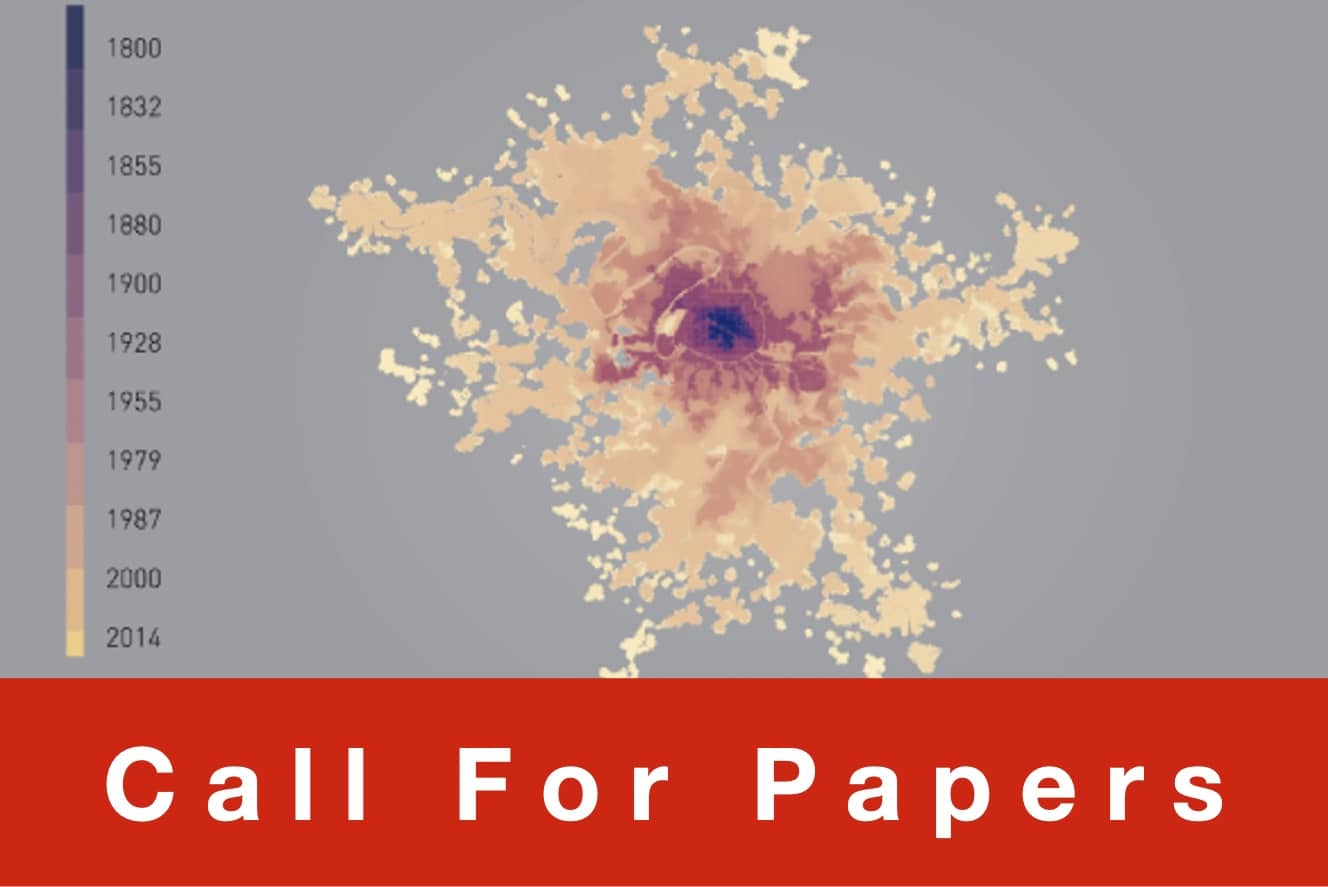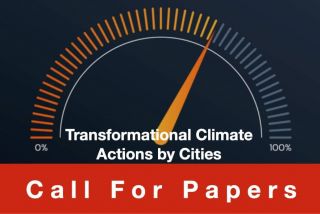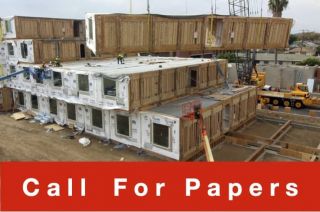
www.buildingsandcities.org/calls-for-papers/urban-expansion.html
Urban Expansion

Guest editor: Shlomo Angel (Marron Institute, New York U.)
Abstract submissions closed on 03 DECEMBER 2021
How can urban expansion be undertaken more sustainably, how can expansion be contained and appropriate strategies created for rapid and modest urban growth?
This special issue explores the quantitative and qualitative dimensions of urban expansion; when, where and how expansion can and should be contained; and when, where, and how it can and should be managed in an orderly, inclusive, and sustainable manner. When cities grow in population, economic output and cultural amenities, they need more physical space. Such space can be created through densification (the focus of a recent B&C special issue) and/or by expanding their footprints into the rural periphery. Urban expansion in geographic space is often ill-defined and its measurement and projection into the future are controversial. 'Sprawl' is detrimental to the surrounding countryside, costly in terms of infrastructure, excessive waste of energy and resources, and increased GHG emissions. But the regulatory containment of urban expansion is problematic as it can result in land and house price inflation, making cities less affordable. The speed of urban expansion has consistently been underestimated especially in the Global South where expansions occur in a disorderly and unplanned manner with negative consequences for inhabitants.
Aims
This special issue will explore whether and where preparing for urban expansion is appropriate; how urban expansion can be undertaken more sustainably; how and where expansion needs to be contained; what are the appropriate strategies for balancing densification and expansion; and how the appropriate expansion strategies can be effectively implemented. Critical analyses of experiences in planning and managing both urban containment and orderly urban expansion are sought that draw pragmatic lessons, for both slow and rapidly growing cities. Such analyses must embrace the many challenges in planning for projected urban expansion in the face of regulatory limitations, local resistance, climate change (e.g. flooding, sea level rise, and mudslides), fiscal and financial constraints, and persistent rural-urban migration.
Research, synthesis, policy analysis and methods papers on urban expansion are sought in four complementary areas:
(1) The quantitative measurement of urban expansion: The definition, measurement, and projection of urban expansion at the municipal, metropolitan, national, and global scale.
(2) Explanatory models of urban expansion: Modeling and explaining the policy and non-policy (economic, social, and cultural) drivers and consequences of urban expansion and of the share of the added populations of cities accommodated by urban expansion vs. urban densification.
3) The containment of urban expansion: Analyses and evaluation of policies that seek to contain urban expansion, evaluations of concrete experiences in containing or slowing down urban expansion, their strengths and limitations, and their utility and appropriateness in cities with varying population growth rates.
(4) Preparing for orderly urban expansion: Analysis and evaluation of policies for urban expansion. Critical evaluations of concrete experiences of planned urban expansion. Short-, middle-, and long-range planning for urban expansion.
Background
(1) The quantitative measurement of urban expansion: The definition and global measurement of urban extents and their expansion over time-essentially using aerial and satellite imagery-is developing rapidly but is still far from reaching consensus on either definitions or measurement methods and hence on the resulting numbers as well. Angel et al (2021), for example, found that a global stratified sample of 200 cities was not able to accommodate more than 25% of the population added to these cities between 1990 - 2014. The rest were accommodated in expansion areas on the urban periphery. Lall et al (2021) challenge these estimates and claim that urban expansion is occurring at a much slower rate.
(2) Explanatory models of urban expansion: Models that seek to explain variations in the rate of expansion of cities (e.g. Seto et al, 2012) typically focus on population, income, and transport cost effects, but rarely incorporate the weaker policy and regulatory effects and are therefore have limited utility in guiding policy. In parallel, the effects of "business as usual" urban expansion on desirable socio-economic outcomes (Ahfeldt and Pietrostefani, 2018), the use of material resources (Hodson et al, 2012), and climate change (Lee and Lee, 2014) have also been the subject of econometric modelling, with improving, but still weak results. A scientific consensus appears quite far away.
3) The containment of urban expansion: The Compact City Paradigm, calling an end to urban sprawl, has been the accepted urban planning doctrine for decades (Burton, 2001 and OECD, 2018), and it is certainly controversial. Hall (1974) documented the severe house price inflation that followed the introduction of green belts in England and South Korea. Others have documented the failure of containment to halt or slow down outward expansion in rapidly growing cities. Development beyond the greenbelt resuls in longer commutes, as in Seoul (Han, 2015). The questions of when containment is appropriate and effective and how its adverse consequences can be avoided remain lively and unresolved.
(4) Preparing for orderly urban expansion: Urban planners have developed tools, notably master plans, for orderly urban expansion (e.g. Cerda's 1859 Ensanche plan for Barcelona (Urbano, 2015)). But many master plans have remained on paper, while cities have fast ignored or outgrown them and expanded in a disorderly manner. This has been especially critical in rapidly growing cities, where regulatory enforcement of zoning and land use is often weak. Unplanned expansion is typically accompanied by the undersupply of arterial roads for public transport that connects the urban periphery to the urban job market, as well as an undersupply of public open spaces and the unregulated development of areas of high environmental risk. Lamson-Hall et al (2018) and Vasconez et al (2017) have engaged in assisting municipalities in rapidly growing cities in Colombia and Ethiopia in making effective preparations for their expansion-acquiring the rights-of-way for arterial roads and securing areas of high environmental risk before development arrives. A critical challenge is planning and land acquisition for public works before development actually occurs.
Suggested Topics
Urban population and area growth: Defining 'urban' areas and identifying them in satellite imagery and population data; measuring historical urban expansion in cities, countries, and regions; forecasting methods for urban expansion in cities, countries, and regions.
Land use and zoning: Reviews of the state-of-the-art in managing urban expansion; the containment unintended sprawl; successes and failures of green belts and urban growth boundaries; urban expansion and the decline of urban densities; compact and non-compact (leapfrogging) urban footprints; land pooling and readjustment schemes; appropriating land for public uses when land is converted to urban use; safeguarding land for future public use.
Urban economics: The effects of urban containment on housing affordability; the economics of urban expansion; econometric models that explain urban extent and expansion; econometric models thatexplain the effects of urban expansion on different socio-economic groups; finance and value capture; comparing infrastructure and resource costs of different urban expansion scenarios; assessing the risk of preparing too much or not enough land for urban expansion.
Environmental and climate impacts: the effects of projected urban expansion on material resources, energy flows and GHG emissions; the projected effect of 'business-as-usual' urban expansion on GHG emissions; safeguarding and enhancing ecosystem services and environmentally sensitive areas on the urban periphery; avoiding natural hazards (flooding, sea level rise. unstable land, etc.); balancing the loss of arable land to urbanization with maintaining a bio-based economy.
Social and community impacts: The social and cultural effects of the inclusion of peripheral settlements into larger cities; the effects of expansion policies on central city conservation and revival; suburbanization and community.
Transport infrastructure and mobility: Ensuring access to urban job markets on the urban periphery; public transport extension into the urban periphery; provision of (local) public services in expansion areas; creating live-work communities and new towns on the urban periphery.
Governance and implementation: short-, middle- and long-range planning for urban expansion; effective interventions in new informal settlement formation; master plans and their limitations; measures to increase density on the urban periphery; land value capture for public infrastructure when land is converted to urban use; governance of urban expansion in multi-authority jurisdictions;municipal human resources constraints for managing urban expansion; political resistance to urban expansion; national and local policies that influence urban expansion; the role of multilateral and bilateral organizations in managing urban expansion; rapid urban expansion to accommodate unexpected refugee flows.
Briefing Note for Contributors
You are invited to submit an abstract for a journal paper in this special issue of Buildings & Cities. In the first instance, please send a 500 word (maximum) abstract defining the scope, methods and results to Richard Lorch richard@rlorch.net by FRIDAY 3 DECEMBER 2021. The initial abstract submission must include:
- The author's and all co-authors' names, affiliations, and contact details
- The question(s) and topics in this Call for Papers that the abstract and intended paper addresses
- The abstract (300-500 words maximum) which should include a description of methods and key findings.
Abstracts will be reviewed by the editors to ensure a varied, yet integrated selection of papers.
Authors of accepted abstracts will be invited to submit a full paper which then undergoes a double-blind peer review process. The journal publishes the several different types of papers: research, synthesis, policy analysis, methods, etc. See: https://bit.ly/3n0mIIz
Timeline
Deadline for abstract submission 3 December 2021
Full papers due 21 March 2022 (NB: authors can submit sooner if they wish)
Referees' comments 01 June 2022
Final version due 11 July 2022
Publication September 2022 (NB: papers are published as soon as they are accepted)
Buildings & Cities journal
Buildings & Cities is an international, open access, not-for-profit, double-blind peer-reviewed research journal. Its focus is the interactions between buildings, neighbourhoods and cities by understanding their supporting social, economic and environmental systems. More information e.g. Aims & Scope, Key Principles and Editorial Board can be found online: www.buildingsandcities.org
Buildings & Cities is an open access journal and has an article processing charge of £1200 (plus VAT if applicable). If you do not have institutional support, please contact the editor to discuss. We endeavour to assist those without funding to publish in our journal.
Questions?
If you have a question, please contact: Richard Lorch richard@rlorch.net or Shlomo Angel sangel@stern.nyu.edu
References
Ahlfeldt, G. and Pietrostefani, E. (2018). Demystifying compact urban growth: evidence from 300 studies from across the world. OECD Regional Development Working Papers, 2018/03. Paris: OECD Publishing.
Angel, S., Lamson-Hall, P., Blei, A. M., Shingade, S., and Kumar, S. (2021). Densify and expand: a global analysis of recent urban growth, Sustainability 13(7), 3835.
Burton, E. (2001). The compact city and social justice. A paper presented to the Housing Studies Association Spring Conference, Housing, Environment and Sustainability, University of York, April.
Hall, P. (1974). The containment of urban England, The Geographical Journal 140(3), 386-408.
Han, A. T. (2015). Evaluating the performance of the greenbelt policy for present and future urban growth management and environmental protection: a case study in the Seoul metropolitan area of South Korea. (Doctoral dissertation, University of Pennsylvania).
Hodson, M., Marvin, S. Robinson, B. and Swilling, M. (2012). Reshaping urban infrastructure: material flow analysis and transitions analysis in an urban context, Journal of Industrial Ecology 16(6), 789-800.
Lall, S. V., Lebrand, M., Park, H., Sturm, D. and Venables, A.J. (2021). Pancakes to pyramids: city form to promote sustainable growth. Washington, DC: World Bank.
Lamson-Hall, P., Angel, S., DeGroot, D., Martin, R. and Tafesse, T. (2018). A new plan for African cities: The Ethiopia Urban Expansion Initiative, Urban Studies 56(6), 1234-1249.
Lee, S. and Lee, B. (2014). The influence of urban form on GHG emissions in the U.S. household sector, Energy Policy 68, 534-549.
OECD. (2018). Rethinking Urban Sprawl: Moving Toward Sustainable Cities. Paris: OECD Publishing.
Seto, K. C., Güneralp, B., and Hutyra, L.R. (2012). Global forecasts of urban expansion to 2030 and direct impacts on biodiversity and carbon pools, Proceedings of the National Academy of Sciences 109 (40) 16083-16088.
Urbano, J. (2016). The Cerdà plan for the expansion of Barcelona: a model for modern city planning, Focus 12(1), Article 13.
Vásconez, J., Galarza, N., Angel, S.Montezuma, R. and Fonseca S. (2015). Preparando ciudades de rápido crecimiento para su expansión: Informe sobre Valledupar y Montería, Colombia, Medio Ambiente y Urbanización 83, 129-154.
Latest Peer-Reviewed Journal Content
Built environment governance and professionalism: the end of laissez-faire (again)
S Foxell
Co-creating justice in housing energy transitions through energy living labs
D Ricci, C Leiwakabessy, S van Wieringen, P de Koning & T Konstantinou
HVAC characterisation of existing Canadian buildings for decarbonisation retrofit identification
J Adebisi & J J McArthur
Simulation and the building performance gap [editorial]
M Donn
Developing criteria for effective building-sector commitments in nationally determined contributions
P Graham, K McFarlane & M Taheri
Reimagining circularity: actions for optimising the use of existing buildings
R Lundgren, R Kyrö, S Toivonen & L Tähtinen
Effective interdisciplinary stakeholder engagement in net zero building design
S Vakeva-Baird, F Tahmasebi, JJ Williams & D Mumovic
Metrics for building component disassembly potential: a practical framework
H Järvelä, A Lehto, T Pirilä & M Kuittinen
The unfitness of dwellings: why spatial and conceptual boundaries matter
E Nisonen, D Milián Bernal & S Pelsmakers
Environmental variables and air quality: implications for planning and public health
H Itzhak-Ben-Shalom, T Saroglou, V Multanen, A Vanunu, A Karnieli, D Katoshevski, N Davidovitch & I A Meir
Exploring diverse drivers behind hybrid heating solutions
S Kilpeläinen, S Pelsmakers, R Castaño-Rosa & M-S Miettinen
Urban rooms and the expanded ecology of urban living labs
E Akbil & C Butterworth
Living with extreme heat: perceptions and experiences
L King & C Demski
A systemic decision-making model for energy retrofits
C Schünemann, M Dshemuchadse & S Scherbaum
Modelling site-specific outdoor temperature for buildings in urban environments
K Cebrat, J Narożny, M Baborska-Narożny & M Smektała
Understanding shading through home-use experience, measurement and modelling
M Baborska-Narożny, K Bandurski, & M Grudzińska
Building performance simulation for sensemaking in architectural pedagogy
M Bohm
Beyond the building: governance challenges in social housing retrofit
H Charles
Heat stress in social housing districts: tree cover–built form interaction
C Lopez-Ordoñez, E Garcia-Nevado, H Coch & M Morganti
An observational analysis of shade-related pedestrian activity
M Levenson, D Pearlmutter & O Aleksandrowicz
Learning to sail a building: a people-first approach to retrofit
B Bordass, R Pender, K Steele & A Graham
Market transformations: gas conversion as a blueprint for net zero retrofit
A Gillich
Resistance against zero-emission neighbourhood infrastructuring: key lessons from Norway
T Berker & R Woods
Megatrends and weak signals shaping future real estate
S Toivonen
A strategic niche management framework to scale deep energy retrofits
T H King & M Jemtrud
Generative AI: reconfiguring supervision and doctoral research
P Boyd & D Harding
Exploring interactions between shading and view using visual difference prediction
S Wasilewski & M Andersen
How urban green infrastructure contributes to carbon neutrality [briefing note]
R Hautamäki, L Kulmala, M Ariluoma & L Järvi
Implementing and operating net zero buildings in South Africa
R Terblanche, C May & J Steward
Quantifying inter-dwelling air exchanges during fan pressurisation tests
D Glew, F Thomas, D Miles-Shenton & J Parker
Western Asian and Northern African residential building stocks: archetype analysis
S Akin, A Eghbali, C Nwagwu & E Hertwich



Latest Commentaries
Building-Related Research: New Context, New Challenges
Raymond J. Cole (University of British Columbia) reflects on the key challenges raised in the 34 commissioned essays for Buildings & Cities 5th anniversary. Not only are key research issues identified, but the consequences of changing contexts for conducting research and tailoring its influence on society are highlighted as key areas of action.
Lessons from Disaster Recovery: Build Better Before
Mary C. Comerio (University of California, Berkeley) explains why disaster recovery must begin well before a disaster occurs. The goal is to reduce the potential for damage beforehand by making housing delivery (e.g. capabilities and the physical, technical and institutional infrastructures) both more resilient and more capable of building back after disasters.